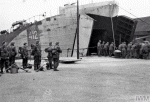NavSource Online: Amphibious Photo Archive
HM LST-412

LST-412 was transferred to the United Kingdom for the duration of World War II
Please report any broken links or trouble you might come across to the Webmaster. Please take a moment to let us know so that we can correct any problems and make your visit as enjoyable and as informative as possible.

Royal Navy History Commissioned into the Royal Navy as HM LST-412, 26 January 1943 HM LST-412 sailed from New York in company with HM LST-324 and HM LST-421, 13 March 1943 transporting refinery equipment to Curacao From Georgetown, Curacao HM LST-412 set sail for Freetown, Sierra Leone Participated in Salerno, Anzio and Normandy operations (MacDermott Ships Without Names) Returned to US Naval control, 23 January 1946
| Click On Image For Full Size Image |
Size | Image Description | Source | |
|---|---|---|---|---|
 |
50k | HM LST-324 and HM 412 unloading logs at Freetown, Sierra Leone, date unknown. | Robert Hurst | |
 |
72k | Rhino ferry F94 moves away from HM LST-320 heading for the Normandy beachhead along the port side of HM LST-412. | Robert Hurst | |
 |
79k | Troops of the 1st Polish Independent Parachute Brigade disembark from HM LST-412, 11-12 October 1944, at Tilbury, England on
their return from the nine day Battle of Arnhem, 17 September- 25 September 1944.
Imperial War Museum, Ministry of Information Censorship Bureau of Press Photographs: Classified Print Collection, Photo No. © IWM (HU 128097) |
Mike Green | |
| Back To The Navsource Photo Archives Main Page | Back To The Amphibious Ship Type Index | Back To The Tank Landing Ship (LST) Photo Index |
| Comments, Suggestions, E-mail Webmaster. |
|
This page is created and maintained by Gary P. Priolo |